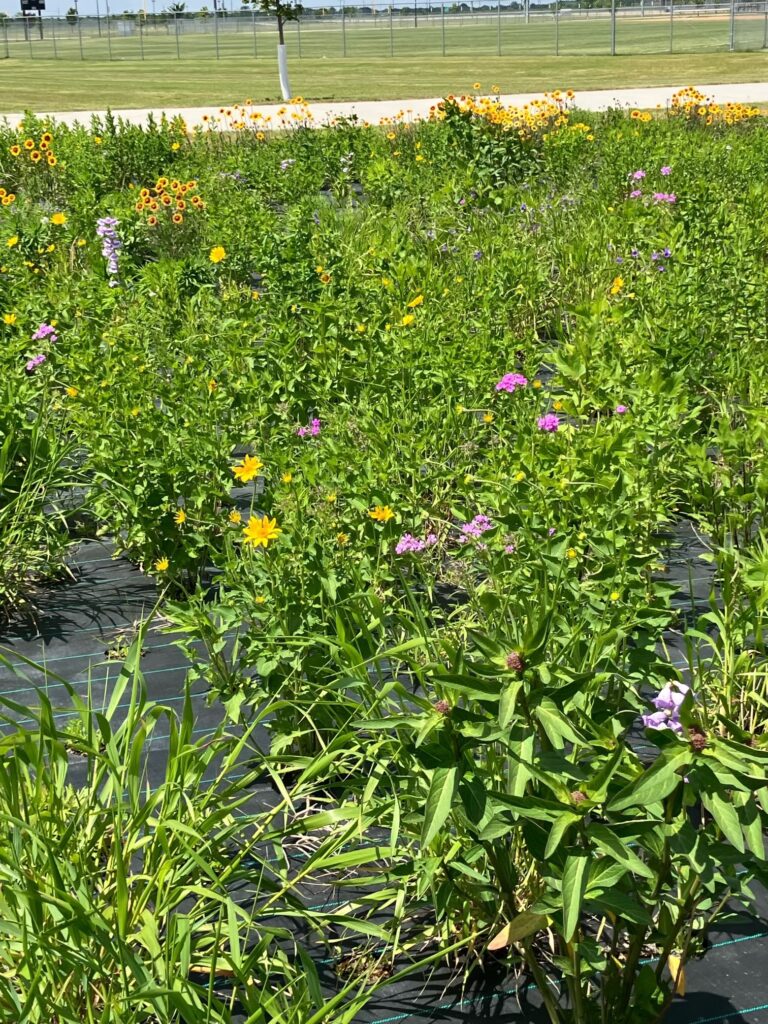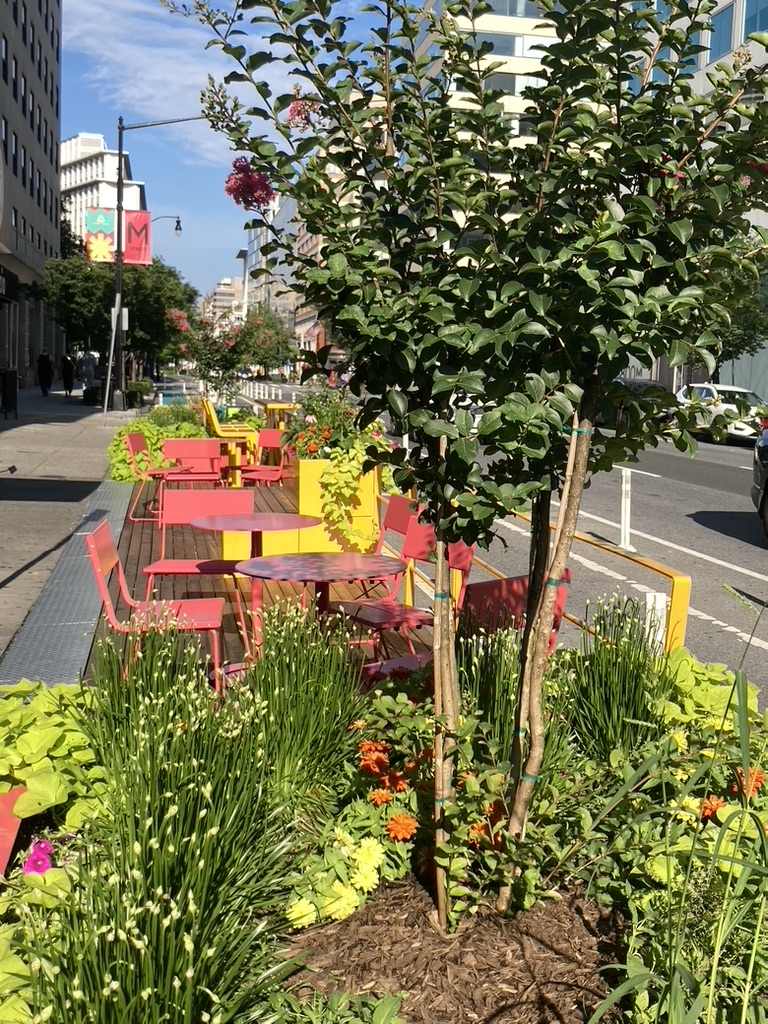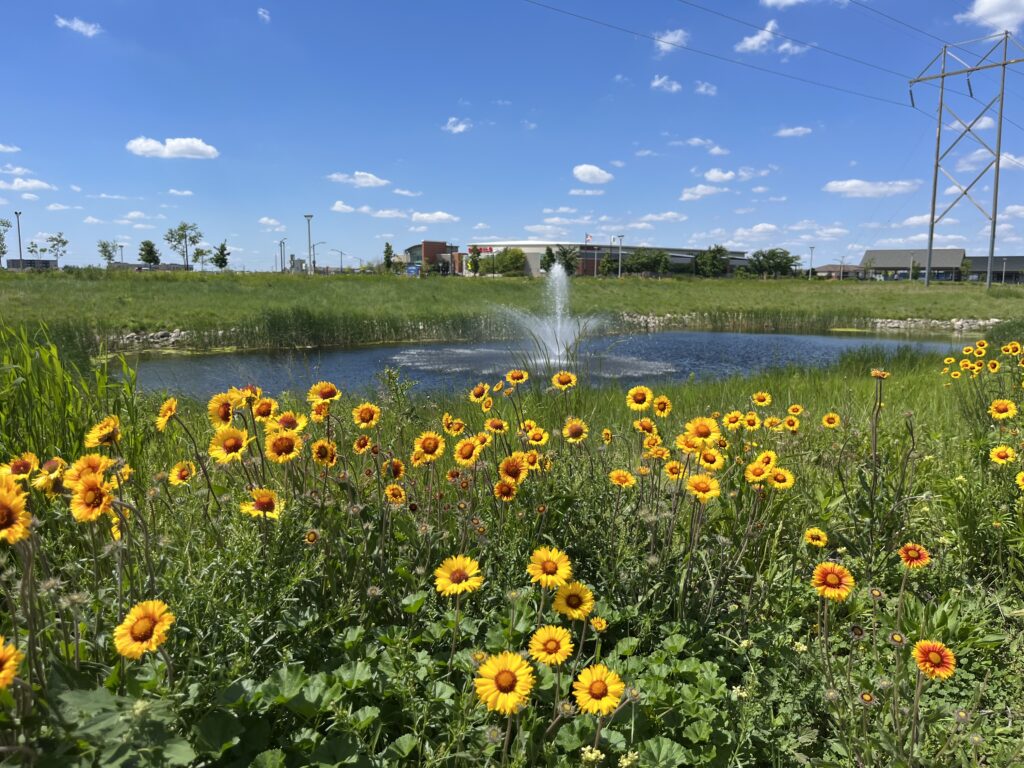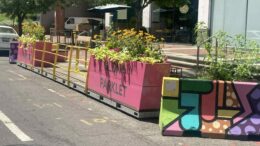Every June, cities around the globe celebrate Pollinator Week, an international event to raise awareness about the important roles that birds, bats, bees, butterflies, beetles, and other small mammals serve in pollinating our food systems and landscapes. These crucial species are declining worldwide, with many on the brink of extinction.
Cities have responded to this crisis with a variety of urban initiatives designed to foster pollinator habitats and in the process transform once-stark cement landscapes — as well as pocket parks, curb strips, and highway dividers — into lush, welcoming areas for pollinators and humans alike.
In Washington, D.C., ambitious pollinator projects are abundant on rooftops of public, office, and private spaces, ranging from the renovated D.C. Public Library’s main branch to National Public Radio’s headquarters, which hosts an apiary. Throughout the District of Columbia, municipal code requires buildings to maintain the tree boxes and curb strips outside their properties. This often leads to creative landscaping on the smallest of scales.

In the city’s Golden Triangle Business Improvement District, a LEED-certified community, an annual competition to engage the neighborhood’s corporate residents in showcasing their tree-box gardening skills has evolved to focus on pollinator habitats.
“For the last four years, the theme of the competition has been ‘happy habitats’,” says Patrick Revord, the director of planning and urban design for the Business Improvement District.
The district published guidelines and scorecards, with specific requirements for pollinators. Building owners and tenants worked with landscape architects to design micro habitats, bee hotels, and other insect shelters.
“Now we have 200 properties who are all doing pollinators because we asked them to,” says Revord. “It’s a much greater reach than we’re able to do as an organization by ourselves.”
One advantage: Creating pollinator habitats is relatively easy. “A lot of places already put plants out in planters and in front of buildings nationwide,” he says. “It’s just a matter of giving people the tools to put the right plants in, and then deputizing them and enabling them to go and make those good decisions.”

It’s not just businesses. Parks and other public spaces also play an important role. For example, Fargo, North Dakota’s Urban Pollinator Plots Project aims to establish more than 50 acres of high diversity, forb-rich, native prairie plantings in urban parklands.
“I think some of the bigger challenges are just simply the establishment of the prairie,” says Sam DeMarais, a park forester in the Fargo Park District, who oversees the program. “It’s a skill set and a knowledge base that really takes a keen eye and some diligence on doing it properly. Everyone thinks you can just plant the prairie and let it go, but that’s not really the case.”
Fargo’s city council has a Sustainability and Resiliency Committee that has helped elevate the public awareness of the program. But for DeMarais it’s an ongoing challenge.
“We have to help people understand, you know, there’s an intent to letting these areas grow,” he says, even if some unexpected or unfamiliar plants pop up along the way. “They’re not just weeds. They’re important pollinator plants. Some weeds are going to come along with that, but a little bit of Canada thistle here and there along with the prairie restoration isn’t such a bad thing.”

Fargo’s and Washington, D.C.’s programs are each over 10 years old, and time has brought knowledge of what works and doesn’t, and the ability to adapt. But less-established initiatives across the country could provide even more clues. A new project at the Port of Vancouver, in Washington state, aims to add a small native plant and flower pollinator garden in the port’s mitigation bank in the Lower Columbia River watershed. It could serve as a case study in introducing pollinators into industrial areas. In Michigan, the nonprofit organization Detroit Hives showcases how to transform vacant lots into pollinator-friendly habitat, a program that recently contributed to Detroit joining the Bee City USA program. Researchers in Puerto Rico are examining the relationships between animal and plant resources in urban areas on the island, and conducting interviews to learn more about public perspectives on plants and wildlife.
But why stop at the city level? Pollinator programs around the world can look to Ireland, where the entire island, north and south, has implemented the All-Ireland Pollinator Plan, a program that brings together community groups, local authorities, councils, businesses, farmers, and others to create a pollinator-friendly landscape.
“We’ve got over 100 different types of wild bee in Ireland and a third of their numbers are going down,” says Kate Chandler, the communities and engagement pollinator officer with Biodiversity Ireland, which manages the program. “The idea is that there’s a series of actions that we can take to change the way we manage our landscape.” The program puts out a series of guidelines, all resources are free, and participation is voluntary. Not everyone has opted in yet, but Chandler is hopeful.
“What we are seeing is that in places where actions have been taken to help them, local pollinator populations are increasing, which is really encouraging,” she says. “Because it shows that what we’re doing is working.”
View this post on Instagram
Getting Started, Avoiding Pitfalls
For communities wanting to start a pollinator project, large or small, Patrick Powell, the chief of staff at the Golden Triangle BID, recommends bringing teams together at the very start of the ideation process. “You have to develop the project in collaboration with your maintenance and planning teams,” he says. “You can’t have something built by your planning or construction department and then have it just dumped on the maintenance folks. And then they’re like, well, this isn’t going to grow here, or this tree is going to get too large and be in the roadway, or this type of drain system is impossible to maintain.”
With a fond chuckle, Powell stresses the importance of streamlining the number of plants used in any particular project for ease of ongoing maintenance.
“Landscape architects, it’s like they get paid by the variety, but sometimes they need some reality,” he says. “I think our initial design for our rain garden had like 60 different bulbs. We were like, we can’t even acquire these. Having construction, design, and maintenance working together, from the beginning, is the best for these types of projects.”
DeMarais also stresses the importance of choosing the correct plants for a restoration or pollinator project.
“A lot of state agencies do native restoration work, so use your local extension services and things like that, or Game and Fish or Department of Natural Resources, to gather information on some of the best practices,” he says. “Also, use true native plants that are local ecotype to your region or your specific area. Those plants are going to provide the best benefits and thrive in your area.” In their case, that meant avoiding prairie species that looked right but which might have functioned differently in their ecosystem. “You can get a common blanket flower, for example, but it may be a blanket flower and the seed came from Texas versus finding seed of a blanket flower that came from North Dakota.”
Chandler echoes that: “Whether you’re talking about different areas of the globe or different areas of the country or even different areas of the city, the habitats that you have in a particular local area will be unique,” she says. “And there will be a unique mixture of species, a unique diversity of flora and fauna, some of which will already be providing a service for pollinators and other biodiversity as well.”
In Fargo, DeMarais says he has seen an increase in pollinators, particularly monarchs, in areas where his team has implemented the program. It’s an encouraging sign that the work they’re doing to restore the prairie is having a positive effect.
“Prairie is being lost by tens of thousands of acres every year,” he says. “It’s almost disappeared from our landscape. And I think as stewards of the land, we need to do our part to make sure that our environments as healthy as possible.”
Additional Resources:
- Pollinator Week’s website
- Bee City
- LEED for Communities
- SITES
- National Wildlife Federation’s Garden for Wildlife program
- S. Department of Agriculture’s Natural Resource Conservation Service
- Xerces Society state lists of native plants for pollinators



